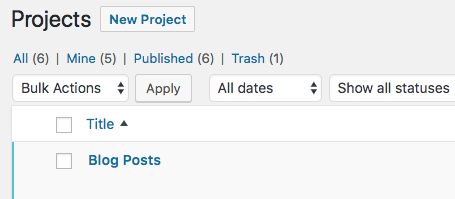This is a guide to understanding where data is stored by UpStream.
First, take a look at a Project. In this example below, the name of the Project is “Blog Posts”.
If I click on the title of this project, the URL of the project is /wp-admin/post.php?post=9&action=edit. This tells us that the ID of the project is 9.

Go to your WordPress site’s database and look for the wp_posts table.
You will see that every project is stored as a post. In the screenshot below, the ID of the project is 9 and the post_title is “Blog Posts”.

Now go to the wp_postmeta table.
- This WordPress.org guide explains what Post Meta is in WordPress.
- This WordPress.org page has an overview of the wp_postmeta table.
In the wp_postmeta table, look for database rows that have the Post ID of 9. This shows you all the data attached to the “Blog Posts” project. In the screenshot below, you can see that this data includes:
- _upstream_project_activity
- _upstream_project_milestones
- _upstream_project_tasks
- _upstream_project_bugs
- _upstream_project_discussion
- _upstream_project_progress
- _upstream_project_members

Click “edit” for one of these rows and you will see the data inside. In the screenshot below, you can see the Tasks attached to the “Blog Posts” project. This data is seralized. WPEngine has a useful introduction to serialized data.

